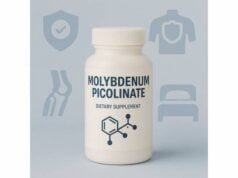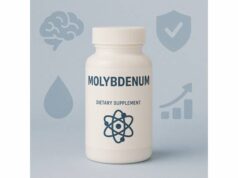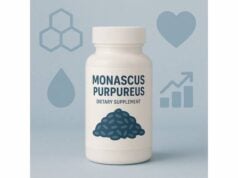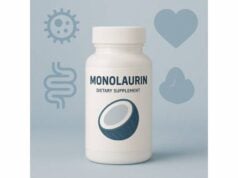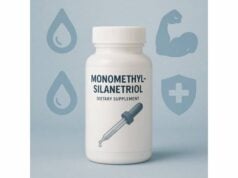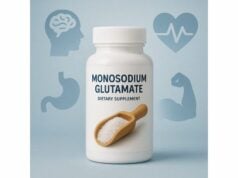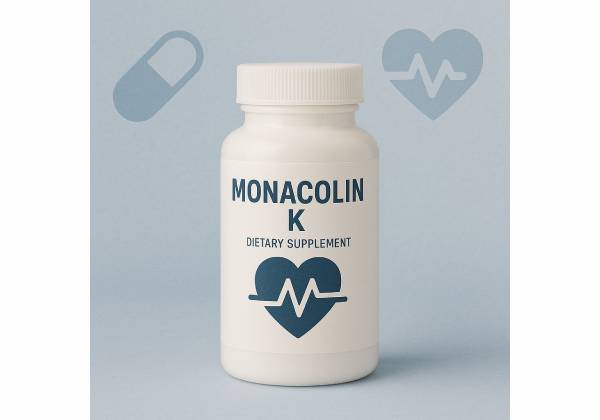
Monacolin K is the cholesterol-lowering compound found naturally in red yeast rice (RYR). Chemically, it is identical to lovastatin, the first prescription statin, which means it works by inhibiting HMG-CoA reductase—the liver enzyme that makes cholesterol. Because of this shared mechanism, monacolin K can meaningfully reduce LDL (“bad”) cholesterol and non-HDL cholesterol, especially in people with mild to moderate elevations. Yet the supplement world is complicated: product potency varies, labeling can be inconsistent, and safety rules differ by country. Some regions limit daily monacolin intake and require warning labels, while others treat high-monacolin products as drugs.
Used thoughtfully and under medical guidance, monacolin K can fit into a broader heart-health plan that includes nutrition, exercise, and sleep. This guide explains what monacolin K is, how well it works, how to use it correctly, what can change your results, common mistakes to avoid, and who should not take it. You will also find a concise evidence and regulation snapshot so you can weigh benefits against risks with clarity.
Essential Insights
- Lowers LDL cholesterol around 15–30% in many trials; best results with lifestyle changes.
- Statin-like safety profile; muscle symptoms and liver enzyme elevations can occur.
- Typical clinical trial amounts provide 3–10 mg monacolin K/day; follow local limits (some regions cap total monacolins at ≤3 mg/day).
- Avoid if pregnant or breastfeeding, with active liver disease, or when taking a statin or strong CYP3A4 inhibitor.
Table of Contents
- What is monacolin K?
- Does it work for cholesterol?
- How to take monacolin K
- Factors that change results
- Common mistakes and troubleshooting
- Safety, interactions, and who should avoid
What is monacolin K?
Monacolin K is a naturally occurring statin produced when the yeast Monascus purpureus ferments rice to make red yeast rice (RYR). In chemical terms, monacolin K is the same molecule as lovastatin, a licensed cholesterol-lowering drug. The match is not just structural; it also shares the mode of action: both inhibit HMG-CoA reductase, a key enzyme in the liver’s cholesterol synthesis pathway. When this enzyme is blocked, the liver pulls more LDL particles out of circulation, which lowers LDL-C and can reduce atherosclerotic risk over time.
Red yeast rice contains a family of related compounds (monacolins A–L), pigments, and other metabolites. Monacolin K is the most clinically relevant because it has the strongest HMG-CoA reductase activity. That said, RYR products vary widely in the amount of monacolin K they deliver per capsule—sometimes by an order of magnitude. Manufacturing controls, the strain of Monascus, fermentation conditions, and extraction methods all influence potency. A separate quality issue is citrinin, a nephrotoxic by-product that can appear when fermentation is poorly controlled. Reputable manufacturers test to keep citrinin “not detected” or below strict limits.
Regulation differs by region. In some countries, authorities restrict the daily amount of monacolins in foods or supplements and require specific warnings. Elsewhere, products with more than trace monacolin K are treated as unapproved drugs, while low-monacolin foods may be allowed with cautionary labeling. Because monacolin K is pharmacologically active, many clinical best practices from statin therapy apply, including attention to drug–drug interactions, symptom monitoring, and periodic lipid measurement.
In everyday use, monacolin K is considered by some people who have mildly elevated LDL-C, those who declined a prescription statin, or individuals with prior statin intolerance who are exploring alternatives under supervision. It should not be used to self-treat high-risk cholesterol profiles without clinician guidance, and it is never a substitute for urgent care in acute coronary symptoms. As with any therapy that modifies cardiovascular risk, the most durable results come from pairing it with diet quality, physical activity, weight management, and sleep hygiene.
Does it work for cholesterol?
Across randomized trials and meta-analyses, monacolin K from red yeast rice consistently lowers LDL-C compared with placebo. Typical average reductions range from about 15% to 30%, with some studies showing greater decreases depending on baseline LDL-C, dose, and product standardization. Total cholesterol and non-HDL cholesterol also fall, while triglycerides tend to modestly decrease. HDL-C effects are generally small.
Why the range? First, studies use different RYR formulations delivering varying amounts of monacolin K—often between 3 and 10 mg/day, though some use higher or combination nutraceuticals. Second, lifestyle baselines differ: people who improve diet quality (higher fiber and unsaturated fats, fewer refined carbs and trans fats) and increase physical activity usually see larger LDL-C and non-HDL-C improvements. Third, adherence matters. Statin-like agents work best when taken daily, long-term.
What about outcomes beyond cholesterol numbers? Some trials of standardized RYR extracts have reported reductions in cardiovascular events in specific populations, especially in secondary prevention settings. These findings are encouraging but may not translate to every formulation on the market, since bioactive content, purity, and dosing can vary. Importantly, event-reduction evidence comes from products made under tight pharmaceutical-style controls, not from the full spectrum of retail supplements. That distinction is critical when you interpret headlines.
In practical terms, here is what most people can expect when monacolin K is used appropriately:
- LDL-C: Average drop of ~15–30% over 8–12 weeks at commonly studied amounts.
- Non-HDL-C: Meaningful decline paralleling LDL-C reductions.
- Triglycerides: Small to moderate decrease; larger effects when baseline TG is elevated and diet improves.
- ApoB: Usually decreases, reflecting fewer atherogenic particles.
- Inflammation markers: Results are mixed and generally modest compared with LDL-C changes.
Two caveats temper the promise. First, monacolin K is a statin in all but name, so the classic statin benefits and risks apply. Second, supplement variability and regulatory differences mean that results are less predictable outside standardized, quality-assured products. If you and your clinician decide to trial monacolin K, plan a follow-up lipid panel at 8–12 weeks to confirm response, then adjust the broader care plan as needed.
Finally, remember that absolute risk reduction depends on your starting cardiovascular risk. A 25% LDL-C reduction matters more (in event terms) for someone with higher baseline risk than for a low-risk person. Use global risk tools, family history, lipoprotein(a), and imaging (when appropriate) to guide the overall strategy.
How to take monacolin K
Forms and labels. Monacolin K is most often consumed via red yeast rice capsules or tablets. Labels may list either the amount of “monacolins” (total) or specifically monacolin K. Some products avoid listing a number, using phrases like “standardized extract.” Because potency varies, pick brands that disclose quantified monacolin content and provide third-party testing for purity and citrinin control.
Amounts used in research. Clinical studies commonly use regimens that provide roughly 3–10 mg monacolin K per day, though some combination nutraceuticals use lower amounts in a multi-ingredient matrix. Local rules may cap the total allowed daily monacolins (e.g., products formulated to provide ≤3 mg/day). Always follow regional regulations and your clinician’s guidance.
Timing. If you use a once-daily product, evening dosing with food is reasonable because hepatic cholesterol synthesis peaks overnight. Extended-release or multi-ingredient products should be taken exactly as directed on the label.
How to start.
- Review your medication list for potential interactions (see Safety section).
- If appropriate in your region, start at a lower monacolin K amount (for example, 2–3 mg/day) to check tolerability.
- Recheck lipids after 8–12 weeks.
- Pair with diet upgrades: more viscous fiber (oats, barley, beans), plant sterol-rich foods, nuts and seeds, and extra-virgin olive oil; reduce refined carbs and trans fats.
- Add regular physical activity (aerobic plus strength training) and adequate sleep.
What to monitor.
- Symptoms: new muscle pain, weakness, dark urine, unusual fatigue, or abdominal discomfort.
- Laboratory: your clinician may check liver enzymes at baseline and if symptoms appear; a repeat lipid panel guides ongoing use.
- Consistency: daily use matters; skipping doses blunts LDL-C reduction.
Stacking with other nutraceuticals. Some combination products include berberine, policosanol, artichoke extract, or coenzyme Q10. These blends aim to improve lipid profiles while supporting tolerability. Evidence varies by ingredient and formulation; do not assume that a mix replicates results from monacolin-only trials.
Special populations.
- Older adults: start low and monitor closely for muscle symptoms and interactions.
- People with hypothyroidism, untreated: correct thyroid function first; hypothyroidism heightens myopathy risk with any statin-like therapy.
- Vegetarians/vegans: monacolin K is compatible, but confirm capsule materials and excipients.
When to stop or switch. If you develop persistent muscle symptoms, significant enzyme elevations, or interaction concerns arise, stop and seek medical advice. For high-risk patients who need larger LDL-C reductions or proven outcome therapies, prescription options (statins, ezetimibe, PCSK9 pathway agents) usually offer clearer benefit–risk profiles.
Factors that change results
Product standardization. The single biggest driver of variability is how much monacolin K your product truly contains. Some capsules labeled as “red yeast rice” deliver only trace amounts; others deliver several milligrams reliably; a few have been found to contain drug-level quantities. Without consistent standardization and independent testing, your expected LDL-C drop becomes a coin toss.
Citrinin control. Citrinin is a fermentation by-product that can harm kidneys. High-quality products document citrinin-free status or meet stringent maximum levels. Because citrinin does not affect taste or smell, you will not detect contamination without lab testing.
Dietary pattern. Diets higher in soluble fiber (oats, barley, psyllium, beans), tree nuts, seeds, and unsaturated fats amplify LDL-C lowering. Diets high in refined carbohydrates, trans fats, and excess alcohol work against you. Combine monacolin K with a Mediterranean-style eating pattern for synergistic effects.
Adherence and dose. Missing doses or taking an under-powered product weakens results. If your clinician approves and local rules allow, titrating within the studied range may help. Conversely, if your region limits total monacolins to ≤3 mg/day, focus on adherence and lifestyle to maximize benefit at the permitted amount.
Genes and physiology. Variants in drug transporters (e.g., SLCO1B1) and metabolism pathways can influence statin exposure and myopathy risk. Hypothyroidism, vitamin D deficiency, low muscle mass, and heavy alcohol use can increase muscle symptom risk. Correct modifiable factors before or during a trial.
Drug interactions. Strong CYP3A4 inhibitors (certain antifungals, macrolide antibiotics, HIV/HCV protease inhibitors) raise monacolin K levels, increasing myopathy risk. Grapefruit (juice or large amounts of fruit) can do the same. Combining monacolin K with prescription statins, high-dose niacin, or fibrates heightens muscle toxicity risk. Always review your medication list.
Health status. Active liver disease, prior statin-associated rhabdomyolysis, or chronic kidney disease (especially with other myotoxic drugs) change the risk–benefit balance. In these cases, clinician-supervised alternatives are preferred.
Measurement timing. Lipid panels should be repeated after 8–12 weeks of consistent use. Shorter windows may miss the full effect; longer intervals slow decision-making. When numbers plateau, reinforce lifestyle tactics or consider a different strategy.
Expectations. Monacolin K is not magic. It works best as part of a plan that includes food quality, movement, sleep, and stress reduction. Think in months and years, not days and weeks, and use numbers (LDL-C, non-HDL-C, ApoB) to guide your choices.
Common mistakes and troubleshooting
1) Buying by brand name, not by content.
Two “red yeast rice” labels can deliver very different amounts of monacolin K. Fix: choose products that quantify monacolin content, show recent third-party testing, and state citrinin status.
2) Doubling up with a prescription statin.
Because monacolin K is lovastatin, combining it with a prescribed statin significantly raises the risk of muscle injury. Fix: do not stack. If you are already on a statin, talk to your clinician before changing anything.
3) Ignoring interaction checks.
Azole antifungals, macrolide antibiotics (e.g., clarithromycin), certain antivirals, some calcium channel blockers, and grapefruit products can elevate monacolin levels. Fix: pause the supplement when you must take an interacting drug, or use an alternative lipid strategy.
4) Pushing the dose without supervision.
More is not always better. At higher exposures, the risk profile mirrors prescription statins, without the same clinical oversight. Fix: stay within locally permitted amounts and monitor symptoms and labs as advised.
5) Skipping lifestyle foundations.
Relying on monacolin K without addressing diet quality, fiber intake, and physical activity leaves much of the potential on the table. Fix: add soluble fiber daily (oats, barley, beans), swap saturated for unsaturated fats, walk or cycle most days, and strength train twice weekly.
6) Expecting quick fixes for high-risk profiles.
If you have very high LDL-C, familial hypercholesterolemia, diabetes with additional risk factors, or established cardiovascular disease, you likely need proven prescription therapies with outcome data. Fix: use guideline-directed therapy and ask whether non-statin agents (ezetimibe, PCSK9-pathway drugs) suit your goals.
7) Not measuring.
Without follow-up lipids, you cannot know whether the supplement worked for you. Fix: recheck a fasting (or consistent non-fasting) lipid panel after 8–12 weeks; track ApoB when available.
8) Overlooking symptoms.
New muscle pain, weakness, or dark urine may signal muscle injury; abdominal pain or jaundice may indicate liver issues. Fix: stop and seek medical evaluation immediately.
9) Choosing combination products for convenience alone.
Multi-ingredient blends vary widely in evidence and dose. Fix: read labels carefully and evaluate each component. Avoid redundant or interacting ingredients.
10) Using during pregnancy or breastfeeding.
Cholesterol synthesis is essential in fetal and infant development. Fix: avoid monacolin K entirely during pregnancy and lactation.
Troubleshooting decision tree (quick guide):
- No LDL-C change at 12 weeks? Confirm monacolin content and adherence; strengthen fiber intake; check for thyroid dysfunction; consider a different therapy.
- Muscle symptoms? Stop immediately, hydrate, seek labs (CK, creatinine) if severe; review interactions; consider rechallenge only under medical supervision.
- Mild liver enzyme rise? Reassess alcohol use, medications, and metabolic factors; repeat labs and adjust plan with your clinician.
- Great response but regulations limit dose? Maximize lifestyle measures and discuss adding a non-statin adjunct with your clinician.
Safety, interactions, and who should avoid
Because monacolin K is pharmacologically identical to lovastatin, the safety profile mirrors statins. Most people tolerate appropriately dosed products well, but important adverse effects can occur.
Common or notable adverse effects
- Muscle symptoms: myalgias, cramps, or weakness; rare cases of myopathy or rhabdomyolysis, especially with interacting drugs or higher exposures.
- Liver enzyme elevations: usually mild and reversible; rare clinically significant hepatotoxicity.
- Gastrointestinal: dyspepsia, nausea, or constipation.
- Neurologic: headache or sleep disturbance, typically transient.
High-risk interaction categories
- Strong CYP3A4 inhibitors: e.g., itraconazole, ketoconazole, clarithromycin, telithromycin, HIV/HCV protease inhibitors; markedly increase monacolin exposure.
- Other lipid agents with myopathy risk: fibrates (especially gemfibrozil) and high-dose niacin.
- Grapefruit products: can raise levels; avoid large amounts.
- Warfarin and other anticoagulants/antiplatelets: monitor closely if ever co-used under supervision.
- Alcohol excess: increases liver risk.
Who should not take monacolin K
- Pregnancy or breastfeeding.
- Active liver disease or unexplained persistent transaminase elevations.
- Concomitant statin therapy (unless a clinician specifically directs otherwise).
- Use of strong CYP3A4 inhibitors that cannot be avoided.
- History of statin-associated rhabdomyolysis or severe intolerance (discuss alternatives).
- Children and adolescents unless specifically prescribed within a supervised plan.
Label and regulatory notes
- Some jurisdictions require warning statements and limit total monacolins to ≤3 mg/day in foods or supplements, given post-marketing reports of serious muscle and liver events even at low intakes in susceptible individuals. Labels may also advise against use with statins and recommend medical supervision.
- In other regions, products containing more than trace monacolin K are treated as unapproved drugs, and enforcement actions have targeted products with added or concentrated lovastatin.
- Quality matters: choose products that document citrinin control and provide recent third-party testing.
Practical safety steps
- Review all medications with a clinician or pharmacist before starting.
- Establish a baseline (lipids, sometimes liver enzymes) and recheck at 8–12 weeks.
- Stop immediately and seek care for muscle pain with weakness, dark urine, or severe fatigue.
The bottom line: monacolin K can be effective for LDL-C lowering, but it is not risk-free, and regulatory frameworks exist precisely because potency and safety vary across products. Treat it with the same respect you would give a prescription statin.
References
- Red Yeast Rice: What You Need To Know 2022 (Guideline/Consumer Health Information)
- COMMISSION REGULATION (EU) 2022/860 of 1 June 2022 amending Annex III to Regulation (EC) No 1925/2006 of the European Parliament and of the Council as regards monacolins from red yeast rice 2022 (Regulation)
- Red Yeast Rice for Hyperlipidemia: A Meta-Analysis of 15 Randomized Controlled Trials 2022 (Systematic Review)
- The Lipid-Lowering Effects and Safety of Red Yeast Rice in Patients with Dyslipidemia: A Meta-Analysis of Randomized Controlled Trials 2023 (Systematic Review)
- Scientific Opinion on the Safety of Monacolins in Red Yeast Rice 2018 (Guideline/Scientific Opinion)
Disclaimer
This article is for educational purposes and does not substitute for personalized medical advice, diagnosis, or treatment. Do not start, stop, or change any medication or supplement without discussing it with your qualified healthcare professional, especially if you have medical conditions, take prescription drugs, are pregnant, or are breastfeeding.
If you found this guide useful, consider sharing it with friends or colleagues on Facebook, X (formerly Twitter), or your preferred platform, and follow us for future evidence-based wellness articles. Your support helps us continue producing high-quality, people-first content.

